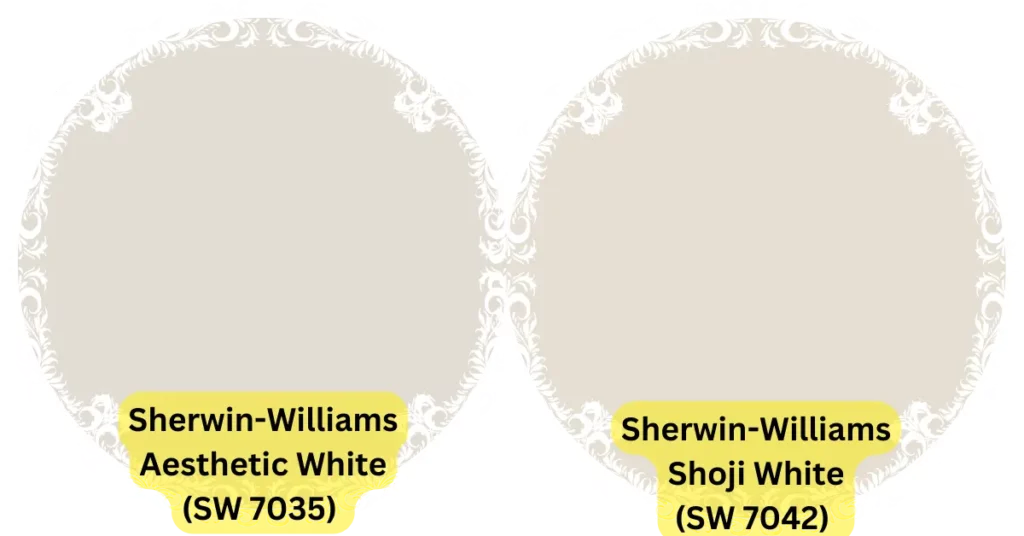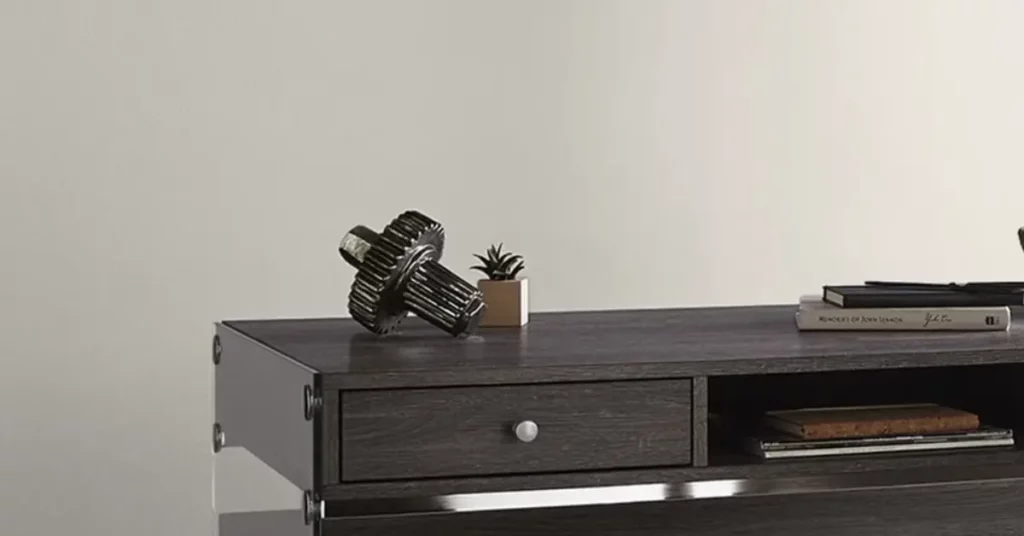Aesthetic White and Shoji White are two popular Sherwin-Williams paint colors. Aesthetic White leans towards a warmer tone, while Shoji White offers a softer warmth with gray undertones.
Choosing the perfect white paint can be a surprisingly complex decision for homeowners and designers. With an array of subtle undertones, each white shade can dramatically affect the mood and aesthetic of a room.
Aesthetic White (SW 7035) and Shoji White (SW 7042) from the Sherwin-Williams collection provide options for those seeking a warm, inviting atmosphere without the starkness of pure white.
Aesthetic White is notably warmer, making it ideal for spaces where a cozy feel is desired, whereas Shoji White, with its subdued warmth and hint of gray, works exceptionally well in spaces that aim for a neutral, serene ambiance. Selecting between these two hues depends largely on the natural lighting of the space and the desired end effect, ensuring the white chosen complements the room’s overall design harmoniously.

Aesthetic White: Exploring The Color Palette
The understated beauty of Aesthetic White has emerged as a favorite among homeowners and interior decorators who prefer a color that conveys sophistication without the starkness often associated with pure whites.
As part of a contemporary color palette, Aesthetic White blends seamlessly into diverse design schemes, softly accentuating the surrounding hues and textures of a space. This versatile shade is not just a simple white; it’s a nuanced color that sets the tone for a calm and welcoming atmosphere, making it an integral part of the aesthetic color palette narrative.
Aesthetic White – Definition And Characteristics
Aesthetic White is a paint color that defies traditional classification – it’s not quite beige and not purely white. Its warm undertones make it stand out from its cooler counterparts, imparting a cozy and inviting ambiance that adapts to various lighting conditions gracefully. This color reflects light in a manner that accentuates spaces with a soft glow, making it an excellent choice for both well-lit and dimly lit rooms.
- Warm undertones that promote a comfortable environment
- Light-reflecting qualities enhance space with a subtle luminance
- Its versatile nature makes it compatible with an array of design styles
- A neutral backdrop allows for creative design freedom
Popular Applications In Interior Design
When it comes to interior design, Aesthetic White has a reputation for versatility and compatibility. Its warm and soft characteristics serve as the perfect background for a variety of decor elements:
| Room/Application | Design Impact |
| Living Rooms | Creates a serene and inviting atmosphere |
| Kitchens | Offers a clean, subtle canvas for countertops and cabinetry |
| Bedrooms | Enhances relaxation with its calming effect |
| Bathrooms | Contributes to a spa-like ambience |
| Trim and Accent Walls | Serves as a harmonious contrast to bolder colors |
Designers frequently recommend Aesthetic White for its adaptability. Whether as a foundation for accents of bold colors or paired with soft, muted tones, this shade provides a harmonious background that elevates other design elements. It’s especially popular in design philosophies like minimalism or Scandi-chic, where the interplay of light and space is essential.
For homeowners who want to infuse their space with a feeling of tranquility without compromising on a modern edge, Aesthetic White offers the perfect balance. It’s capable of making small rooms seem larger and giving a luxe finish to every design it graces.

Shoji White: Unraveling The Aesthetics
Let’s start a journey through the serene yet commanding presence of Shoji White. A color that encapsulates subtlety and warmth—a neutral with the power to transform spaces into havens of minimalist elegance. Delving into Shoji White, we uncover an aesthetic blend that appeals to purists and modernists alike. It’s a hue that invites tranquility and reflects a sophisticated balance, making it highly sought after by designers and homeowners striving for a harmonious interior.
Shoji White – Origins And Cultural Significance
The roots of Shoji White are deeply intertwined with Japanese culture. ‘Shoji’ refers to the traditional paper screens used in Japanese interior design, known for their gentle diffusion of light and connection to nature.
This color embodies the essence of those timeless screens—it’s not merely a shade but a reflection of a lifestyle that cherishes simplicity and mindfulness. In Western design, Shoji White captures this spirit, infusing spaces with a sense of peace and cultural history.
Infusion Of Traditional And Modern Influences
Shoji White is a true testament to the fusion of past and present. It’s a shade that honors its traditional roots while seamlessly adapting to contemporary settings.
It anchors a room with a soft, neutral background, providing a versatile canvas for a variety of decor styles—be it the clean lines of modern furniture or the rich textures of traditional elements. The result is an aesthetic that bridges time, harmonizing the classic with the current to create interiors that are both fresh and timeless.
- Timeless Appeal: Perfect for those seeking a color that outlasts trends
- Adaptability: Complements a wide range of design aesthetics from minimalist to luxe
- Mood Setting: Sets a calming backdrop that heightens focus and reduces stress
Aesthetic White Vs Shoji White: Color Psychology
Colors have a profound impact on our emotions and how we perceive spaces. The shades of white we choose for our environments can subtly influence our mood, thoughts, and behavior. Beyond their practical application, colors like Aesthetic White and Shoji White play pivotal roles in color psychology, setting the tone for our homes and workspaces. Let’s delve into how these hues affect the ambiance and perception, as well as how they can be harnessed to create balance and serenity.
Aesthetic White is a warm and soft shade of white that can transform any room into a cozy haven. Its gentle undertones make it a perfect backdrop for a variety of design elements, allowing them to stand out without overpowering the senses:
- Boosting Warmth: It emanates a comfortable warmth, ideal for creating inviting spaces.
- Enhancing Natural Light: Aesthetic White reflects natural light beautifully, enhancing the room’s brightness.
- Complementing Textures: This hue pairs well with textured materials, adding depth to the decor.
- Subtle Sophistication: When used in interiors, it provides a sophisticated canvas for artwork and furniture.
Psychologically, Aesthetic White is associated with purity and cleanliness, but its warm undertones bring a comforting and stabilizing energy. It’s conducive to concentration and clarity of thought, making it ideal for not only living spaces but also for home offices and creative corners.
Shoji White sits at the crossroads of white and light greige, exuding a sense of balance and tranquility. Its versatile nature allows for seamless integration into various aesthetic themes, from minimalistic to rustic:
| Shoji White Attributes | Impact on Space |
| Neutral Undertones | Offers a peaceful and neutral backdrop, allowing personal style to shine. |
| Softness | Softens sharp lines and harsh lighting, reducing visual stress. |
| Versatility | Complements various color palettes and brings cohesion to diverse elements. |
| Modern Yet Timeless | Achieves a modern edge while maintaining timeless appeal. |
In color psychology, Shoji White aligns with serenity, providing a calming presence that promotes relaxation and peace of mind. Its subtle grey undertones foster a sense of stability and grounding that’s perfect for bedrooms, bathrooms, and areas dedicated to meditation or reflection.
Choosing Between Aesthetic White And Shoji White
When it’s time to refresh a space with paint, selecting the right color can be an unexpected challenge. White may seem like a simple choice, yet the subtle variances in undertone and brightness make a world of difference. Two popular shades in the spotlight are Aesthetic White and Shoji White.
The right choice sets the tone for the room’s ambiance and enhances the aesthetic appeal. Let’s compare the unique qualities of Aesthetic White and Shoji White, helping you choose the best candidate for your next interior transformation.
Aesthetic White: Matching With Different Styles And Tones
Aesthetic White by Sherwin Williams is a nuanced shade that offers more warmth than a stark white, making it a versatile choice for a variety of design styles. Its underlying beige tones allow it to seamlessly integrate into warm color palettes, while also standing out against cooler hues.
- Traditional: Enhances the elegance of classic wood trims and furniture.
- Modern: Serves as a subtle backdrop for bold modern art and furnishings.
- Boho: Complements natural textures and earthy tones.
- Minimalist: Creates a sense of calm and uncluttered space.
Catering to different lighting scenarios, Aesthetic White maintains its character under both natural and artificial light sources, offering consistency throughout the day.
Shoji White: Complementing Various Design Elements
Shoji White is another Sherwin Williams favorite with its slight greige undertone that adds sophistication to any room. Shoji White excels in complementing various design elements and materials, due to its neutral yet warm presence.
- Textured Fabrics: Amplifies the depth of textures such as linen or tweed.
- Metallic Accents: Offers a stunning contrast to metals like brass, gold, or chrome.
- Wood Tones: Harmonizes beautifully with both dark and light wood grains.
- Stone Features: Pairs perfectly with marble, granite, or other stone finishes.
Shoji White is particularly adept in spaces where various materials converge, presenting a cohesive canvas that unites disparate textures and colors.
Table illustrating Aesthetic White and Shoji White
| Characteristic | Aesthetic White | Shoji White |
| Undertone | Beige | Greige |
| Best Used With | Warm hues and diverse styles | Varied textures and mixed materials |
| Lighting | Adaptable to various lighting conditions | Consistent in different light settings |
Insert a call to action for paint samples
Eyeing Aesthetic White or contemplating Shoji White? Consider observing paint samples in your space at different times of the day. This hands-on approach ensures your final pick aligns perfectly with your interior’s unique characteristics.
Aesthetic White And Shoji White In Different Lighting
Choosing the right shade of white for your space can be a surprisingly complex task. Two popular contenders, Aesthetic White and Shoji White, offer unique vibes that can transform your home. However, lighting plays a significant role in how these colors present themselves. Delve into the subtleties of how Aesthetic White and Shoji White react to different lighting conditions, and discover which hue suits your environment best.
Impact Of Natural Light On Aesthetic White
Aesthetic White by Sherwin-Williams is a warm white with a slight gray undertone. In a room bathed in natural light, this color takes on a bright and inviting tone. It can, however, exhibit different properties throughout the day. Consider the following:
- Direct sunlight: A room with abundant sunshine will enhance the warmer side of Aesthetic White, making it feel cozy and alive.
- Indirect sunlight: In spaces with subtle sunlight, Aesthetic White remains consistent, providing a neutral background that complements various décor styles.
- Shaded areas: With less natural light, Aesthetic White can appear more muted and even slightly cooler, making it versatile for different design schemes.
Because of this, Aesthetic White is an exceptional choice for rooms with varying natural light, offering a dynamic backdrop that evolves with the changing daylight.
Shoji White: Adaptability In Artificial Lighting
Conversely, Shoji White, also by Sherwin-Williams, carries a softer beige undertone that’s exemplary for ambient, artificial lighting. Here’s how it conforms:
| Artificial Light Type | Effect on Shoji White |
| Warm White Bulbs: | Emphasizes the beige essence, enhancing a warm and inviting atmosphere. |
| Cool White Bulbs: | Neutralizes warmth slightly, offering a crisper appearance while maintaining softness. |
| Dimmed Lighting: | Creates an intimate mood, subtlety showcasing its beige character for a tranquil setting. |
In artificial lighting, Shoji White showcases its versatility, making it a stellar option for evenings and rooms with limited daylight. Its adaptability to different light sources means it can serve a myriad of interior styles gracefully, from modern to rustic chic.

The Influence Of Texture And Material
The nuanced hues of Aesthetic White and Shoji White paint colors have a profound impact on interior spaces, influenced heavily by the textures and materials they are paired with. Understanding how these subtle shades interact with different surfaces can help homeowners and designers create a desired ambiance within a room.
Aesthetic White: Enhancing Tactile Experiences
Aesthetic White (SW 7035) is a nuanced shade that adds a sense of sophistication and depth to living spaces. This color is not merely about visual appeal; it actively enhances the tactile experience of the different textures it is applied. When Aesthetic White is paired with rough-hewn wood or a matte finish, it brings forward an earthy, textured feel to the space.
- On smooth surfaces: The subtlety of Aesthetic White amplifies the sleekness of polished marble or glossy tiles, making it a versatile choice for kitchens and bathrooms.
- When combined with fabrics: Whether it’s the richness of velvet upholstery or the casual elegance of cotton drapes, Aesthetic White adapts to the material, reflecting light in a way that accentuates the fabric’s texture.
- For architectural details: Molding, trim, and wainscoting coated in Aesthetic White gain prominence, highlighting the craftsmanship and intricate details of the woodwork.
Shoji White: Embracing Minimalism And Delicacy
In contrast, Shoji White (SW 7042) is all about embracing minimalism and the delicate nature of the spaces it occupies. This whisper-soft hue resonates with an understated elegance that complements minimalist designs. It provides a clean canvas that allows materials and textures to stand on their own, without being overwhelming.
| Material | Impact with Shoji White |
| Glass & Metals | Enhances the reflectivity and sheen, giving objects a lighter, ethereal quality. |
| Natural Wood | Offers a serene backdrop, allowing the warmth and natural grain of wood to be the focal point. |
| Textiles | Softens the look and feel, whether it’s the drape of linen or the coziness of wool. |
The magic of Shoji White lies in its ability to let textures shine without competition. It’s the perfect backdrop for an interior that values subtlety and wants to make a statement through the interplay of light, shadow, and material detail.
Maintenance And Longevity Considerations
Choosing the right paint for your home involves not only picking the perfect shade but also considering the maintenance and longevity of the color. Both Aesthetic White and Shoji White bring their distinct characteristics to the table, which can impact their appeal’s ease of upkeep and duration. Let’s find out what makes each of these shades practical and durable, ensuring your interiors look fresh and inviting for years to come.
Aesthetic White: Practicality And Ease Of Maintenance
Aesthetic White stands out as a highly versatile and low-maintenance option for homeowners. Its ability to mask minor imperfections and resist showing dirt and smudges makes it a practical choice for high-traffic areas in the home.
- Scruff-Resistant: This shade tends to be forgiving with everyday wear and tear, making touch-ups less frequently needed.
- Easy Clean-up: Stains and spills can easily be wiped away without affecting the paint’s finish, ensuring a long-lasting pristine look.
- Adaptive: It complements various lighting conditions, which means less time spent adjusting decor and more time enjoying the space.
Furthermore, Aesthetic White’s smooth finish allows for simpler general maintenance routines – occasional dusting or a light wash will keep the walls looking as good as new.
Shoji White: Durability And Timeless Appeal
In contrast, Shoji White is known for its durability and timeless charm. Its resilience makes it an excellent pick for those seeking longevity without frequent touch-ups.
| Feature | Benefit |
| High Opacity | Fewer coats required, retaining its richness over time |
| Advanced Formulation | Resists fading and yellowing, even in sunlit rooms |
| Peel-Resistant | Remains intact, ensuring a flawless finish for longer periods |
Shoji White continues to enchant homeowners with its warm undertones that maintain a classic presence in any room. Its robust nature translates to a color that stands the test of time, both in style and structure.
In conclusion, when selecting between Aesthetic White and Shoji White, maintenance and longevity should be crucial factors in your decision-making process. Opt for Aesthetic White if you’re after practicality and ease of maintenance or choose Shoji White if you prioritize durability with a timeless appeal.
Conclusion
Choosing between Aesthetic White and Shoji White boils down to your decor style and ambiance preference. While Aesthetic White offers a warm and versatile backdrop, Shoji White brings a softer, more nuanced charm to spaces. Remember, the right shade can elevate your home’s aesthetic beautifully.
Trust your vision and make the choice that aligns with your unique taste and home’s character.

S. Pushon is a paint expert, self-taught artist, and currently working as an adviser in the paint industry as a Quality Improvement and Development Assistant.
An artist by heart, he draws remarkable art pieces and as a professional paint industry individual, he seeks the insight and shares with enthusiasts. Read more…
